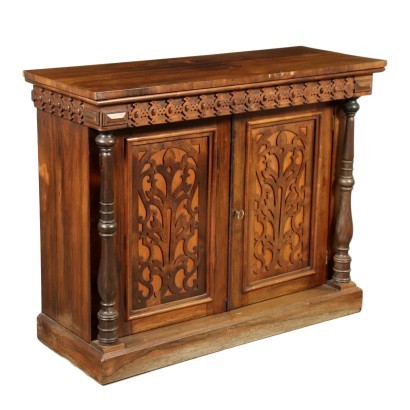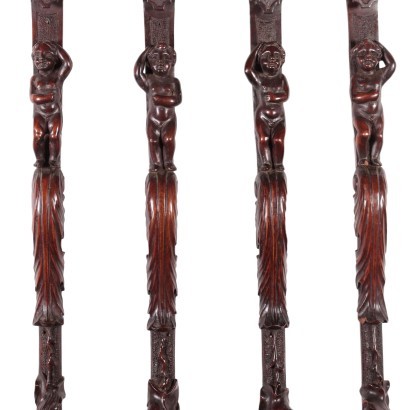French Neo-Renaissance Bookcase France 19th Century
Features
Style: Neo-Renaissance (1820-1890)
Age: 19th Century / 1801 - 1900
Origin: France
Main essence: Rosewood , Pine , Sessile Oak
Description
French Neo-Renaissance bookcase with two doors decorated with a pierced phitomorphic motif to which had been added panels to close them. The pillars are made of refined columns that support the lightly projecting undertop band that is decorated with modular motif that had been applied on. Pine and sessile oak interiors.
Product Condition:
Fair condition. Wear consistent with age and use. Any damage or loss is displayed as completely as possible in the pictures. Product with a Certificate of Authenticity and Lawful Origin.
Dimensions (cm):
Height: 92
Width: 114,5
Depth: 45
Additional Information
Age: 19th Century / 1801 - 1900
19th Century / 1801 - 1900 Main essence:
Rosewood
Under the term Rosewood various exotic, hard and heavy woods have been united, characterized by a color that varies from pink to violet. Their origin is usually from Latin America, India and Africa and are still considered very valuable woods. Until the end of the eighteenth century, this name also referred to the bois de violette . In general, rosewood woods began to be imported into Europe starting in 1750 and were first used for veneers and inlays in England, flanked, by contrast, with lighter woods. Later, entire valuable furniture was manufactured both in England, mainly in the Regency style, and in France, starting from the Neoclassical period.
Pine
The term pine wood indicates the essence from various species of conifers, especially Scots pine, maritime pine and pinea pine. Used since ancient times for the most common furniture, with the advent of the veneer technique, in the 1600s, it was widely used in the construction of the structure of even luxury furniture, which were then covered, decorated (in Venice) or gilded ( in England). It has a color that varies from white to yellow with reddish hues and can be both very soft and very hard.
Sessile Oak
Under the name of oak or oak various types of woods derived from plants of the genus quercus are grouped. They are always resistant, hard and compact woods. Oak is lighter than oak, both are used for more rustic furniture or for the interiors of French and English antique furniture. In other processes it was gradually replaced by the advent of exotic woods considered more valuable since the 18th century. 



























